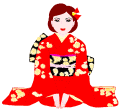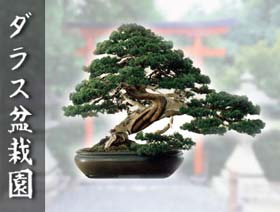|

In
1195 A.D., during Heian era, Buddhist monks brought Bonsai
art to Japan, future masters' home. In this country styles developed
simultaneously to social changes, from a first moment of extreme
essentiality (Bunjin style) - to which the most famous picture "Saigyo
Monogatari Emaki" dates back (about 1250), to Kamakura
(1180-1333 A.D.) and Muramachi period (1333-1573
A.D.). The representation of a bonsai story in Noh Theatre belongs to
this time: "Hachino-ki" -"the tree in the
container" -written by the author Seami, tells about a poor
man, once wealthy, who gives shelter to a beggar; to warm him a little, he
offers to burn three bonsai trees, the last of his ancient collection. In
spite of the beggar's refusal, actually one of shogun Kamakura's regents,
he gets fire to the plants.
In Edo period (1614-1868 A.D.),
characterized by an increase in pottery and chinaware manufacture, bonsai
practise spread quickly. During the same centuries the oligarchic
government issued both edicts against Christianity and the entrance of
foreigners into the reign (1587-1615) and single laws, like the one
which obliged all feudal lords to move with their suite to Edo (Tokyo)
once a year and reach the shogun's court; on those occasions there were
real competition in giving the supreme commander splendid gifts, among
them the first rare bonsai specimens. The anachronistic feudal society and
the consequent isolation of Japan from the rest of the world caused a
temporary standstill of bonsai culture, which revived after the revolution
of Meiji period (1868-1912), encouraging style codification
just to the First International Exhibition - the Kokufo-ten -,
taken place in Tokyo in 1928. This exhibition has been
repeating itself every year till today.
In Europe bonsai art was imported in 1853 by
an Englishman, Robert Fortune, representative of the Royal
Horticultural Society of London, but it developed only after World War II,
though the several International Exhibitions in Paris (1867,
1889, 1900), London (1862, 1910) and Vienna
(1873). The first European book on bonsai trees, titled "The
shaping of Japanese dwarf trees", was written by the French botanist Albert
Maumené in 1902.
Back |





